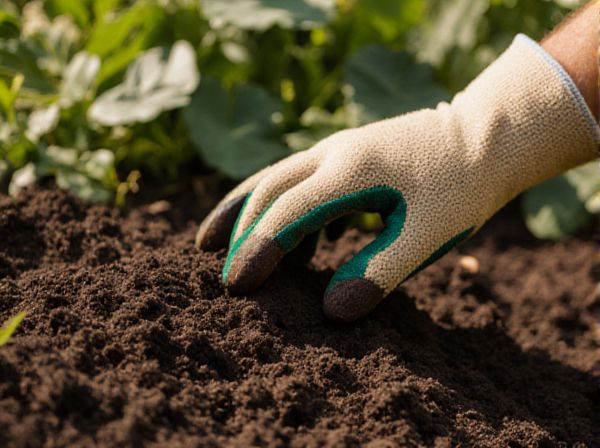
Turning Compost vs No-Turn Compost Illustration
Turning compost accelerates the decomposition process by increasing aeration, which helps maintain optimal oxygen levels for microbial activity, resulting in faster nutrient-rich soil production. No-turn compost relies on a slower, passive breakdown, preserving beneficial fungi and microorganisms but requiring more time to achieve full maturity. Choosing between turning and no-turn compost methods depends on balancing time constraints with the desired microbial diversity and soil health benefits.
Table of Comparison
| Aspect | Turning Compost | No-Turn Compost |
|---|---|---|
| Process | Regularly aerated by physically turning the pile | Relies on natural aeration without physical turning |
| Decomposition Speed | Faster, typically 4-8 weeks | Slower, often 3-6 months |
| Labor Intensity | High - requires manual or mechanical effort | Low - minimal intervention needed |
| Odor Control | Better aeration reduces odor | Potential for stronger odors due to limited airflow |
| Temperature | Maintains higher temperatures for pathogen kill | Lower temperatures, slower pathogen reduction |
| Moisture Management | Easier to adjust moisture during turning | Moisture control less precise |
| End Product Quality | Uniform, well-aerated, nutrient-rich | May be uneven, with variable nutrient distribution |
Introduction to Turning Compost vs No-Turn Compost
Turning compost accelerates decomposition by regularly aerating organic materials, which promotes microbial activity and reduces odors. No-turn compost relies on natural processes and microbial communities developing over time, requiring minimal labor but extending the composting period. Understanding the balance between aeration, moisture, and microbial dynamics is essential when choosing between turning and no-turn composting methods.
Key Differences Between Turning and No-Turn Methods
Turning compost accelerates decomposition by introducing oxygen, enhancing microbial activity and reducing composting time to a few weeks. No-turn compost relies on passive aeration and slower microbial breakdown, requiring several months but conserving labor and minimizing disturbance to beneficial organisms. Key differences include speed, oxygenation level, microbial dynamics, and maintenance effort.
Benefits of Turning Your Compost Pile
Turning your compost pile accelerates decomposition by introducing oxygen, which enhances microbial activity and reduces unpleasant odors. This process also helps to evenly distribute moisture and heat, ensuring faster and more efficient breakdown of organic materials. As a result, turned compost typically produces nutrient-rich humus quicker than no-turn compost methods.
Advantages of No-Turn Composting
No-turn composting reduces labor and energy costs by eliminating the need for frequent aeration, making it a more sustainable and efficient method. This process promotes the development of beneficial microbial communities through slower, natural aerobic decomposition, resulting in nutrient-rich compost. No-turn compost piles also retain moisture better and produce less odor, enhancing overall compost quality and environmental impact.
Essential Materials for Each Composting Method
Turning compost requires essential materials such as a balanced mix of carbon-rich brown materials like dried leaves and straw, nitrogen-rich green materials like kitchen scraps and fresh grass clippings, and sufficient moisture to promote aerobic decomposition. No-turn compost relies heavily on coarse materials like wood chips or shredded branches to allow airflow without manual agitation, combined with layered organic waste to maintain proper moisture and microbial activity over time. Both methods benefit from incorporating nitrogen sources such as manure or food waste to accelerate breakdown and achieve nutrient-rich compost.
Step-by-Step Guide: How to Turn Compost
Turning compost accelerates the decomposition process by introducing oxygen and evenly distributing moisture and microbes throughout the pile. To turn compost, begin by checking the moisture level, ensuring it feels like a wrung-out sponge, then use a pitchfork or compost aerator to mix the outer layers into the center thoroughly. Repeat this process every 1-2 weeks to maintain aeration and promote efficient breakdown of organic material.
How No-Turn Composting Works: Process Overview
No-turn composting relies on layering organic materials and allowing natural microbial activity to break them down over time without mechanical agitation. This method maintains moisture and temperature levels by controlling aeration through proper pile management and occasional watering. The slow decomposition process results in nutrient-rich compost while reducing labor and minimizing disturbance to beneficial soil organisms.
Speed and Efficiency: Breaking Down Compost Faster
Turning compost accelerates microbial activity by increasing oxygen flow, resulting in faster decomposition and nutrient-rich humus formation within weeks. No-turn compost, while requiring less labor, decomposes slower as limited aeration restricts microbial efficiency, often taking several months to mature. Optimizing oxygen levels through regular turning dramatically improves speed and efficiency in breaking down organic matter.
Troubleshooting Common Issues in Both Methods
Turning compost improves aeration and speeds up decomposition, but may cause moisture loss and temperature fluctuations if done excessively. No-turn compost maintains moisture and microbial balance longer but can experience odor problems and slower breakdown due to reduced oxygen flow. Monitoring moisture levels and adjusting carbon-to-nitrogen ratios are essential troubleshooting steps in both methods to promote efficient composting and prevent issues like foul smell or incomplete decomposition.
Choosing the Right Compost Method for Your Garden
Turning compost accelerates decomposition by increasing oxygen flow and maintaining uniform moisture levels, resulting in faster nutrient-rich humus ideal for gardens needing quick soil enrichment. No-turn compost conserves microbial diversity and reduces labor, making it suitable for low-maintenance gardeners willing to wait longer for mature compost. Selecting between turning and no-turn compost depends on your garden's timeline, available effort, and desired compost quality.
Turning Compost vs No-Turn Compost Infographic

 gardendif.com
gardendif.com